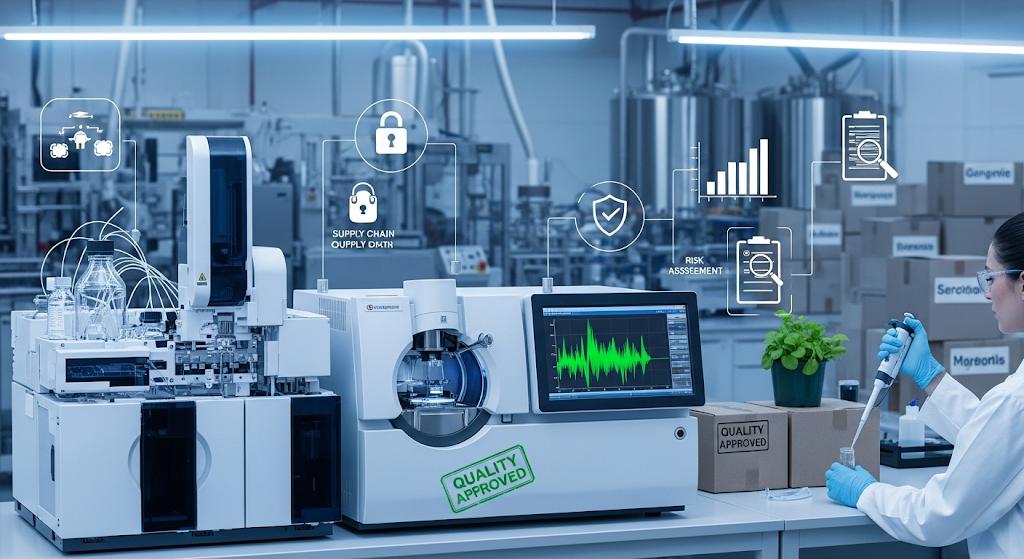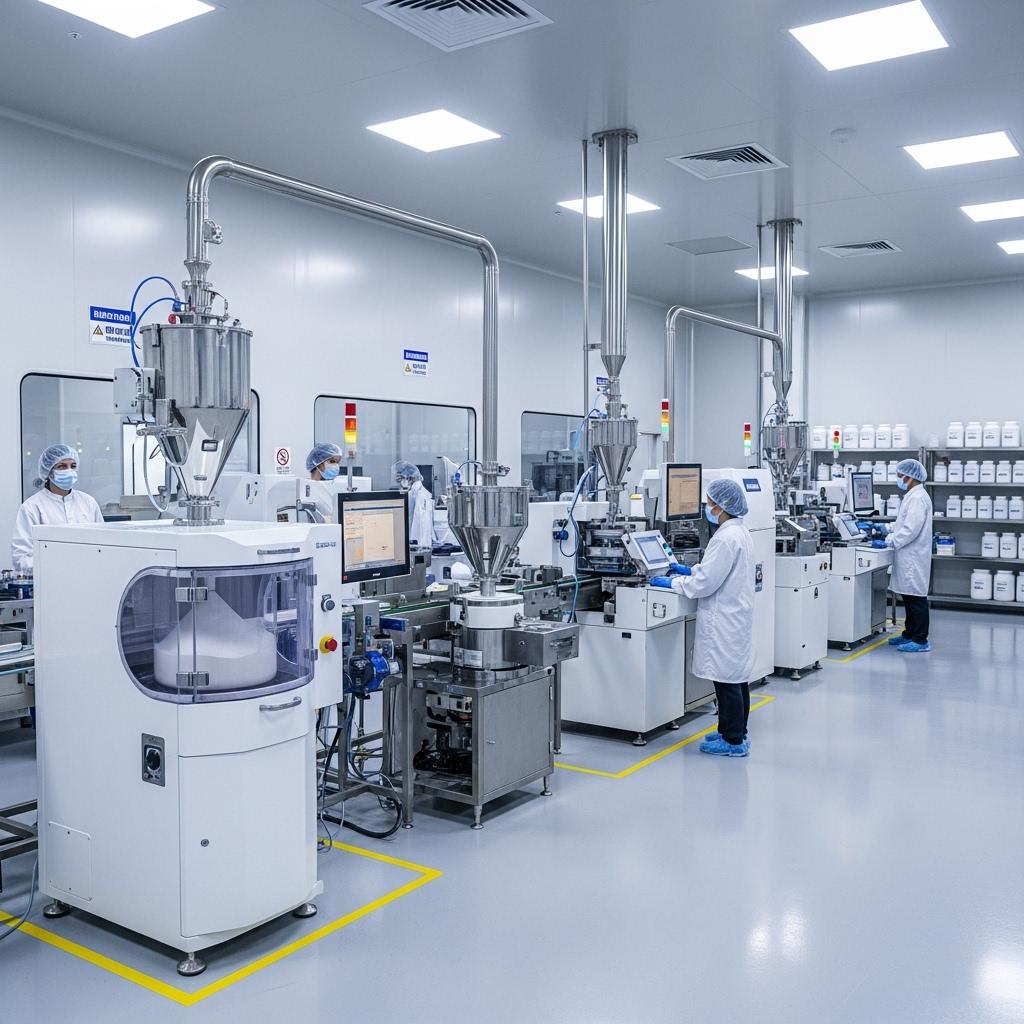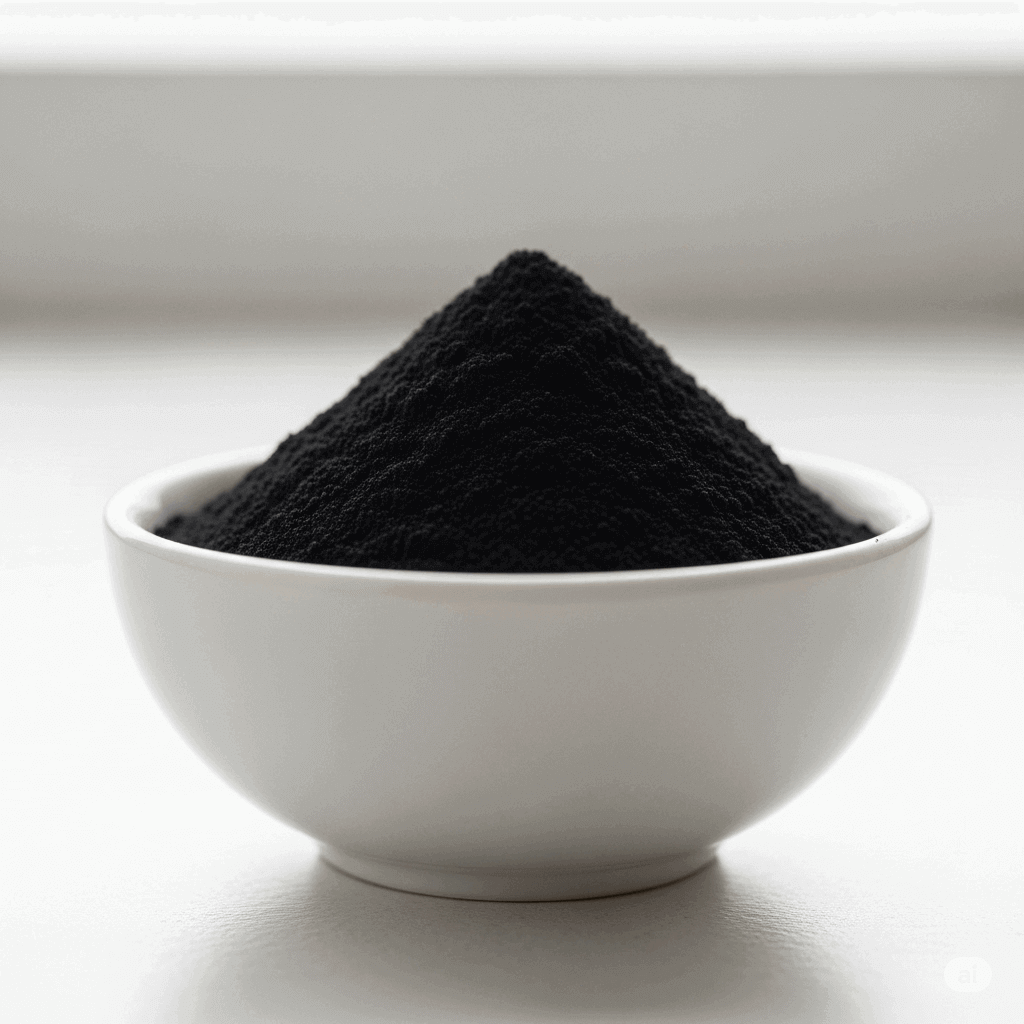Collagen is a foundational protein, vital for the structure and function of nearly every tissue in the human body. As interest in its health and beauty benefits has surged, so too has the market for collagen-based supplements. Yet, amidst the wide array of products, terms like "collagen" and "collagen peptides" are often used interchangeably, leading to widespread confusion about their true nature and impact.
This guide dives deep into the science behind these two forms, illuminating their fundamental distinctions, production methods, and how these differences critically influence their absorption, biological activity, and suitability for various applications. For product developers, researchers, and anyone committed to understanding the genuine efficacy of collagen, grasping these nuances is essential for making informed choices and unlocking the protein's full potential.
I. What is Collagen? The Architect of Body Structure
At its essence, collagen is the most abundant protein in the human body, constituting approximately 25% to 35% of the total protein mass. It serves as the primary structural component of connective tissues, acting as the "scaffolding" that provides integrity, strength, and elasticity to virtually every tissue and organ.
The Unique Triple-Helix Structure of Native Collagen
Native, or intact, collagen is characterized by its remarkable and highly stable triple-helical structure. This complex macromolecule is formed by three individual polypeptide chains, known as alpha chains, each coiled into a left-handed helix. These three helices then intertwine to form a right-handed superhelix. This intricate structure is exceptionally rich in specific amino acids, predominantly:
-
Glycine (~33%): Crucial for the tight packing of the helix.
-
Proline (~10%): Contributes to the stability of the helix's turns.
-
Hydroxyproline (~10%): A unique amino acid to collagen, formed post-translationally from proline, and vital for stabilizing the triple helix through hydrogen bonding.
This tightly wound, fibrous structure provides immense tensile strength, allowing collagen to withstand significant stretching forces. It's what gives skin its firmness, bones their rigidity, and tendons their ability to transmit force.
Key Characteristics of Native Collagen:
-
High Molecular Weight: Typically ranges from 100,000 Daltons (Da) to over 300,000 Da.
-
Insolubility: Largely insoluble in cold water; it can swell in water but does not readily dissolve.
-
Limited Bioavailability: Due to its large size and complex structure, native collagen is very difficult for the human digestive system to break down into absorbable components. When consumed, it would primarily be digested into individual amino acids, losing any potential signaling benefits of intact peptides.
Sources of Native Collagen for Industrial Use:
Native collagen used for further processing or specific applications is typically derived from animal by-products:
-
Bovine (Cattle): From hides, bones, and cartilage.
-
Porcine (Pig): From skin and bones.
-
Marine (Fish): From skin, scales, and bones.
-
Avian (Chicken): From sternal cartilage and other tissues.
Native collagen finds applications in specialized fields like biomedical engineering (e.g., wound dressings, tissue scaffolds), but its direct oral supplementation for systemic benefits is limited due to its poor absorption.
II. What are Collagen Peptides? The Bioavailable Evolution
Collagen peptides, also widely known as hydrolyzed collagen or collagen hydrolysate, represent a technologically advanced form of collagen specifically engineered for superior bioavailability and functional efficacy in dietary supplements. They are essentially native collagen that has undergone a controlled enzymatic process to break down its large, complex structure into smaller, more digestible protein fragments called peptides.
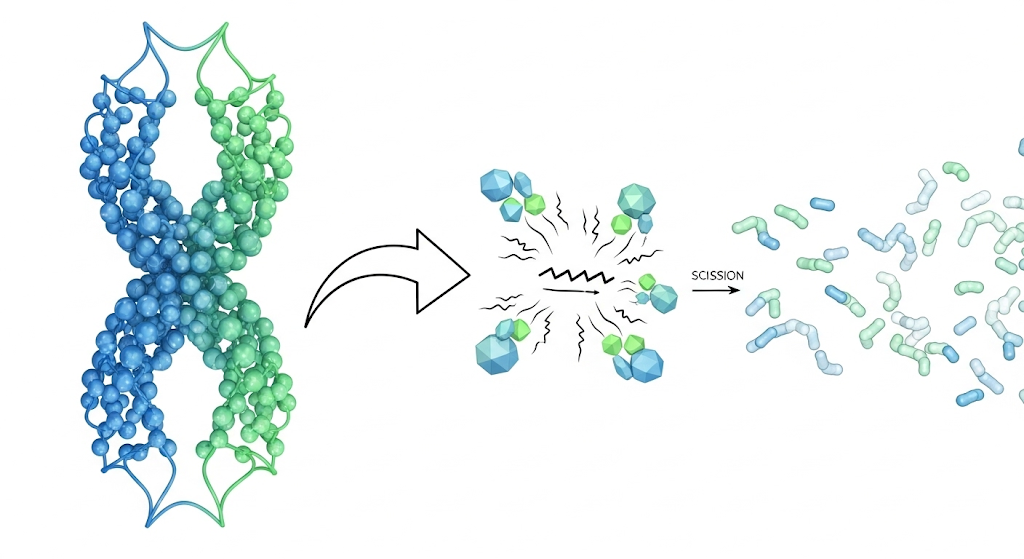
The Hydrolysis Process: Precision Breakdown
The transformation of native collagen into collagen peptides occurs through hydrolysis, which literally means "breakdown by water." This process typically involves:
-
Preparation: Native collagen sources (e.g., bovine hides, fish skins) are cleaned and demineralized.
-
Gelatinization: The raw collagen is heated in water to break some of the cross-links, forming gelatin. Gelatin is a partially hydrolyzed form of collagen that forms a gel when cooled. Its molecular weight is significantly lower than native collagen but still higher than collagen peptides (typically 50,000-100,000 Da).
-
Enzymatic Hydrolysis: The gelatin solution is then treated with specific proteolytic enzymes (proteases). These enzymes precisely cleave the peptide bonds within the collagen chains, breaking them down into shorter chains of amino acids – the collagen peptides. The type of enzyme, temperature, pH, and reaction time are carefully controlled to achieve a specific molecular weight profile and optimize the presence of certain bioactive peptides.
-
Filtration & Purification: The solution is filtered to remove impurities, followed by concentration.
-
Drying: The concentrated solution is spray-dried or lyophilized (freeze-dried) to produce a fine, soluble powder.
Key Characteristics of Collagen Peptides:
-
Low Molecular Weight: The average molecular weight of collagen peptides typically ranges from 500 Da to 10,000 Da, with many commercial products targeting specific ranges (e.g., 2,000-5,000 Da for optimal bioavailability). This small size is crucial for absorption.
-
High Bioavailability: Unlike native collagen, collagen peptides are readily absorbed across the intestinal barrier into the bloodstream. They can pass through the small intestine largely intact as di-peptides (two amino acids) and tri-peptides (three amino acids), or even larger oligopeptides, which can then be transported to target tissues.
-
Cold Water Soluble: Due to the complete breakdown of the triple-helix structure, collagen peptides dissolve easily in both hot and cold liquids without clumping or gelling.
-
Neutral Organoleptic Properties: High-quality collagen peptides are generally tasteless and odorless, making them highly versatile for integration into various food products and beverages without altering their sensory profile.
-
Non-Gelling: Unlike gelatin, collagen peptides do not form a gel when cooled, allowing for diverse applications.
III. The Fundamental Distinction: Size, Solubility, Bioavailability – And Its Profound Impact on Efficacy
The defining difference between native collagen and collagen peptides lies in their molecular size, which directly dictates their solubility and, most critically, their bioavailability. This distinction is not merely academic; it directly translates to how effectively the body can utilize these proteins for therapeutic benefits.
| Feature | Native (Intact) Collagen | Collagen Peptides (Hydrolyzed Collagen) |
| Structure | Complex triple-helix, large fibrous protein. | Short chains of amino acids (di-, tri-, and oligopeptides); no intact triple-helix. |
| Molecular Weight | Very High (e.g., >100,000 Da, often up to 300,000 Da). | Low (e.g., typically 500-10,000 Da). Specific bio-active peptides like Pro-Hyp (Proline-Hydroxyproline) and Hyp-Gly (Hydroxyproline-Glycine) are <500 Da. |
| Solubility | Insoluble in cold water; swells and forms a gel (gelatin) in hot water upon cooling. | Highly soluble in both hot and cold water; remains liquid, does not gel. |
| Digestion | Requires extensive and inefficient enzymatic breakdown by gastric proteases (pepsin) in the stomach, leading to random amino acid release. | Already "pre-digested" through hydrolysis. Pass through the stomach largely intact as peptides. Absorbed rapidly in the small intestine via specific peptide transporters (e.g., PEPT1) or paracellular pathways. |
| Bioavailability | Extremely Poor when consumed orally. Large molecules are not absorbed into the bloodstream in meaningful quantities. Benefits, if any, are likely due to general amino acid contribution, not targeted peptide signaling. | Excellent. Absorbed as intact peptides (di- and tri-peptides) that enter systemic circulation and are transported to target tissues (skin, joints, bones), where they can act as both building blocks and signaling molecules. |
| Mechanism | Primarily acts as a food protein source. | Dual Action: 1. Provides specific amino acids (Glycine, Proline, Hydroxyproline) as building blocks. 2. Acts as signaling molecules to stimulate endogenous collagen, hyaluronic acid, and elastin production by fibroblasts. |
| Applications | Limited oral supplement use; mainly food gelling agent (gelatin), medical materials. | Primary form for oral dietary supplements, functional foods, beverages. |
The Significance of Bioavailability:
The ability of collagen peptides to be absorbed as intact di- and tri-peptides is crucial. Research suggests that these specific peptides, particularly those containing hydroxyproline (e.g., Pro-Hyp, Hyp-Gly), are not merely building blocks but also act as signaling molecules. They can reach target cells like fibroblasts in the skin, chondrocytes in cartilage, and osteoblasts in bone, stimulating them to increase their own production of collagen, elastin, and hyaluronic acid. This "signal" is what differentiates the true efficacy of collagen peptides from simply consuming a general protein source.
IV. Dissecting Collagen Types: Targeted Benefits for Product Formulations
While all collagen peptides are hydrolyzed, their original source determines the predominant collagen types they contain, which can offer targeted benefits for specific health goals. Understanding these types is vital for creating effective and market-specific supplement lines.
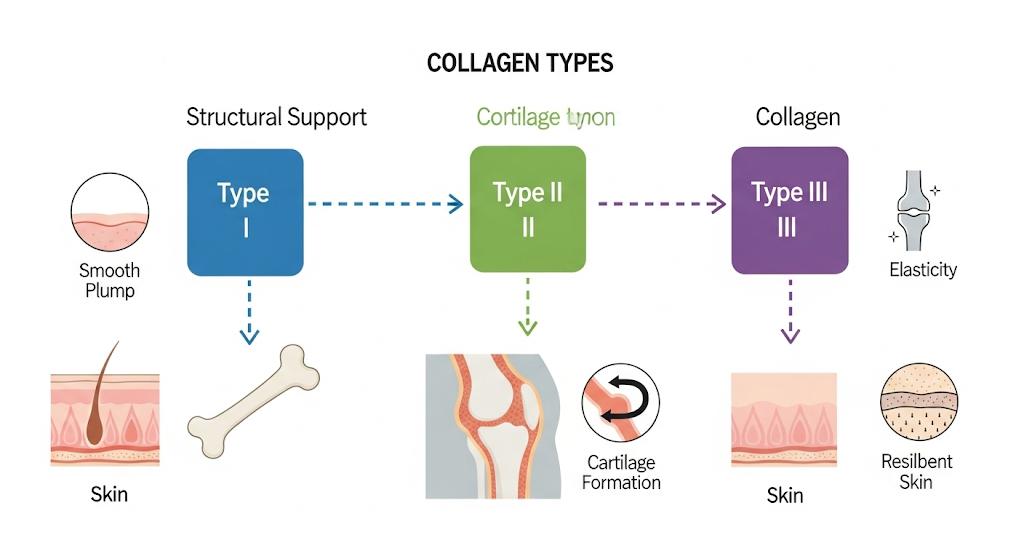
There are at least 28 identified types of collagen, but a few dominate the human body and supplement market:
-
Type I Collagen:
-
Abundance: The most prevalent collagen type in the human body, constituting about 90% of total collagen.
-
Body Distribution: Found in skin, bones, tendons, ligaments, fibrous cartilage, teeth, and connective tissues of organs.
-
Primary Benefits: Crucial for skin elasticity, firmness, and hydration; bone strength and density; tendon and ligament integrity; hair and nail health.
-
Common Sources for Peptides: Bovine hides, marine (fish) skin and scales.
-
Supplement Application: Ideal for beauty-from-within (skin, hair, nails), bone health, and general connective tissue support.
-
-
Type II Collagen:
-
Abundance: Less abundant than Type I, but the primary collagen in articular cartilage.
-
Body Distribution: Exclusively found in cartilage, providing its strength and elasticity.
-
Primary Benefits: Essential for joint health, cushioning, and flexibility. Supports cartilage structure and function.
-
Common Sources for Peptides: Chicken sternal cartilage, bovine cartilage.
-
Supplement Application: Primarily used for joint health, osteoarthritis support, and sports-related joint stress.
-
Crucial Distinction: Hydrolyzed vs. Undenatured (Native) Type II Collagen:
-
Hydrolyzed Type II Collagen Peptides: Fully broken down into small peptides. They act as building blocks and signaling molecules for chondrocytes (cartilage cells) to synthesize new cartilage components. Often found in multi-collagen blends.
-
Undenatured (Native) Type II Collagen (e.g., UC-II®): This form is processed at very low temperatures to preserve its intact triple-helix structure. Its mechanism of action is distinct: it works via oral tolerance, modulating the immune system to reduce inflammatory responses that can break down cartilage. It's effective at much lower doses (e.g., 40mg/day) than hydrolyzed peptides. Product developers must understand this difference, as their efficacy, dosage, and claims are entirely separate.
-
-
-
Type III Collagen:
-
Abundance: The second most abundant collagen type, often found alongside Type I.
-
Body Distribution: Abundant in skin, blood vessels, and internal organs (e.g., intestines, liver, lungs). Forms a reticular (net-like) fiber structure.
-
Primary Benefits: Contributes to skin elasticity and youthfulness, supports the integrity of blood vessels and organs.
-
Common Sources for Peptides: Bovine hides (often found together with Type I in bovine collagen peptides).
-
Supplement Application: Frequently combined with Type I for comprehensive skin health and overall structural support.
-
-
Type V Collagen:
-
Abundance: Less common but widespread.
-
Body Distribution: Found in cell surfaces, hair, placenta, and often associated with Type I collagen in various tissues.
-
Primary Benefits: Plays a role in fibril organization of Type I and III, important for hair and skin structure.
-
Common Sources for Peptides: Chicken collagen, eggshell membrane.
-
Supplement Application: Increasingly included in hair, skin, and nail supplements for a broader approach.
-
-
Type X Collagen:
-
Abundance: A minor but specialized collagen type.
-
Body Distribution: Predominantly found in hypertrophic and mineralizing cartilage (e.g., growth plates in bones), and plays a role in endochondral ossification (bone formation).
-
Primary Benefits: Associated with bone health and growth, especially in young bone and cartilage during development and repair.
-
Common Sources for Peptides: Chicken sternal cartilage.
-
Supplement Application: Targeted for bone health and some joint formulations.
-
Many premium supplements offer multi-collagen blends, combining peptides from diverse sources (bovine, marine, chicken, eggshell membrane) to provide a broader spectrum of collagen types (e.g., I, II, III, V, X). This holistic approach aims to deliver comprehensive benefits across multiple bodily systems.
V. Beyond Type: Critical Considerations for Sourcing & Formulating Your Collagen Product Line
Developing a successful collagen supplement line extends beyond merely choosing a collagen type. Strategic sourcing, meticulous processing, appropriate delivery forms, and robust certifications are equally vital for product efficacy, consumer trust, and market success.
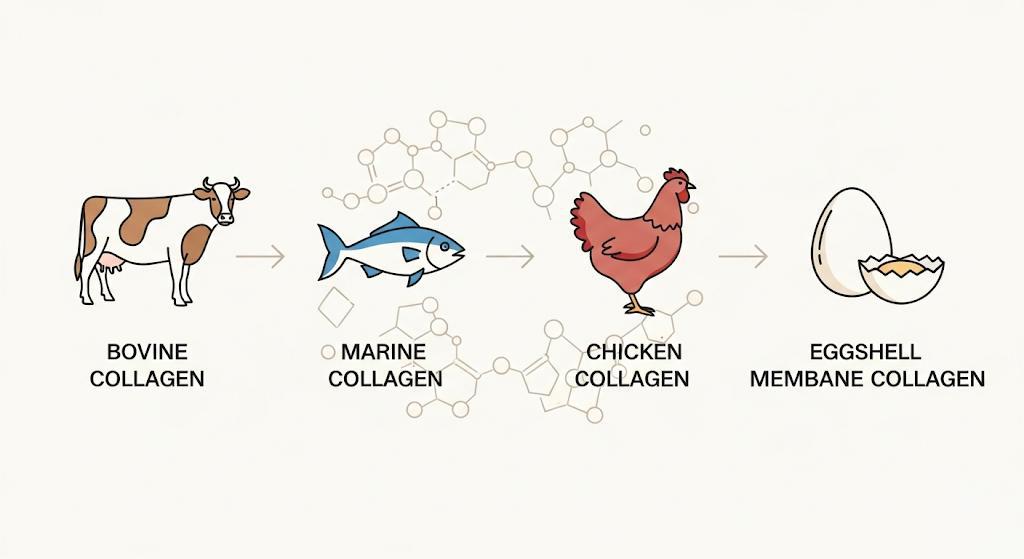
1. Source Matters: Nuances of Raw Material Selection
The animal source impacts not only the collagen types but also amino acid profiles, sustainability, cost, and market perception.
-
Bovine Collagen Peptides:
-
Pros: Most widely available and cost-effective. Primarily Type I and III. Can be sourced from grass-fed, pasture-raised animals, appealing to certain consumer segments. Good for general skin, bone, and connective tissue health.
-
Cons: Not suitable for pescatarian or vegan diets. May have some concerns regarding sourcing practices if not from reputable suppliers.
-
-
Marine (Fish) Collagen Peptides:
-
Pros: Predominantly Type I. Often boasts a smaller molecular weight (though this can vary by processing), potentially leading to faster absorption. Considered more sustainable if sourced from wild-caught, by-product fish. Pescatarian-friendly. Often perceived as "premium."
-
Cons: Generally more expensive. Can sometimes retain a slight "fishy" odor or taste if not highly purified. Not suitable for individuals with fish allergies.
-
-
Chicken Collagen Peptides:
-
Pros: Excellent source of Type II collagen, making it ideal for joint health formulations. Can also contain Types V and X.
-
Cons: Less commonly used for Type I and III specific products.
-
-
Eggshell Membrane Collagen:
-
Pros: A unique, natural source containing multiple collagen types (I, V, X), along with naturally occurring elastin, hyaluronic acid, chondroitin sulfate, and glucosamine. Offers a comprehensive profile for joint and skin health.
-
Cons: Newer to the market, may be higher cost, and supply might be more limited than bovine or marine. Not suitable for egg allergies.
-
-
Plant-Based "Collagen Boosters" / Vegan Collagen Alternatives:
-
Important Clarification: True collagen is an animal-derived protein. Plant-based "collagen" products are not collagen but rather blends of plant-derived amino acids (especially glycine, proline, hydroxyproline-analogues) and co-factors (Vitamin C, zinc, copper, silica, hyaluronic acid, biotin) that are crucial for the body's endogenous collagen synthesis.
-
Market Appeal: Caters to vegan/vegetarian consumers and those avoiding animal products.
-
Formulation Strategy: Brands can create compelling products for this growing segment by carefully selecting amino acids and synergistic nutrients to support the body's natural collagen production.
-
2. Molecular Weight Profile: The Absorption Goldilocks Zone
While "lower molecular weight" is generally desired for bioavailability, there isn't a single ideal molecular weight for all collagen peptides. Different average molecular weight ranges might influence which specific peptides are absorbed and potentially target different tissues more effectively.
-
Typical Range: Most high-quality collagen peptides range from 500 Da to 10,000 Da.
-
Smaller Peptides (e.g., <1,000 Da): Often associated with rapid absorption and potential for direct signaling.
-
Larger Peptides (e.g., >2,000 Da): Still bioavailable, and may contribute more significantly as building blocks once broken down further.
-
Analytical Methods: Reputable manufacturers use techniques like Gel Permeation Chromatography (GPC) or Size Exclusion Chromatography (SEC) to characterize the molecular weight distribution of their collagen peptides.
3. Delivery Forms: Tailoring to Consumer Preferences and Product Efficacy
Collagen peptides' excellent solubility and neutral sensory profile allow for a wide range of delivery forms, enabling brands to cater to diverse consumer segments.
-
Powders:
-
Pros: Most common and cost-effective. High dosage flexibility. Can be mixed into various beverages (coffee, smoothies, water).
-
Cons: Requires mixing. Some consumers dislike the texture if not fully dissolved.
-
-
Capsules/Tablets:
-
Pros: Convenient, tasteless, precise dosage. Portable.
-
Cons: Limited dosage per serving, requiring multiple capsules for higher daily intake.
-
-
Gummies:
-
Pros: Palatable, enjoyable, highly appealing to broader demographics (including children). Perceived as a treat.
-
Cons: Often contain added sugars. Lower active ingredient dose per gummy. Stability challenges for certain sensitive ingredients.
-
-
Liquids/Ready-to-Drink (RTD):
-
Pros: Rapid absorption. Convenient. Can incorporate other active ingredients.
-
Cons: Higher production costs. Shorter shelf life. Bulkier for transport.
-
-
Bars/Functional Foods:
-
Pros: Integrated into daily diet. High consumer appeal.
-
Cons: Formulation challenges to maintain stability and taste.
-
-
Topical Applications: While the article primarily focuses on oral supplements, it's worth noting that collagen peptides are also used in skincare creams. However, their topical absorption into deeper skin layers is debatable due to skin barrier function, and oral intake is generally considered more effective for systemic skin benefits.
4. Quality, Purity & Certifications: Building Trust and Ensuring Compliance
For a successful collagen product line, adherence to the highest standards of quality, purity, and ethical sourcing is non-negotiable.
-
Good Manufacturing Practices (GMP): Essential for any reputable supplement manufacturer, ensuring consistent quality, safety, and purity of the final product.
-
Third-Party Testing: Independent laboratory testing for:
-
Heavy Metals: Lead, mercury, cadmium, arsenic.
-
Microbial Contaminants: Bacteria, yeast, mold.
-
Pesticides & Herbicides: Especially for grass-fed or organic sources.
-
Purity & Potency: Verifying the actual collagen peptide content and absence of fillers.
-
-
Clean Label & Transparency: Consumers increasingly demand products free from artificial colors, flavors, sweeteners, preservatives, and common allergens (gluten, soy, dairy). Transparency in sourcing and processing builds trust.
-
Certifications for Market Access and Consumer Preference:
-
Halal Certified: Crucial for markets with large Muslim populations (e.g., Middle East, Southeast Asia). Ensures compliance with Islamic dietary laws from raw material to final product.
-
Kosher Certified: Important for Jewish consumers, ensuring adherence to Kashrut laws.
-
Non-GMO Project Verified: Appeals to consumers concerned about genetically modified organisms.
-
Gluten-Free Certified: Essential for individuals with celiac disease or gluten sensitivity.
-
GRAS (Generally Recognized As Safe) Status: Indicates the ingredient is recognized by experts as safe under the conditions of its intended use.
-
Sustainability Certifications: For marine collagen, certifications like MSC (Marine Stewardship Council) indicate sustainable fishing practices. For bovine, certifications for humane animal treatment.
-
-
Traceability: The ability to trace raw materials from source to finished product provides immense reassurance about quality and ethical practices.
VI. Conclusion: Unlocking Collagen's Full Potential Through Informed Choices
Understanding the intricate difference between collagen and collagen peptides is the bedrock for successful product development in the thriving health and wellness industry. While native collagen serves as the body's vital structural scaffold, it is the scientifically engineered collagen peptides—with their low molecular weight, superior solubility, and high bioavailability—that unlock the true potential for oral supplementation.
From distinguishing between Type I and Type II, to navigating the nuances of bovine versus marine sources, and ensuring stringent quality control with relevant certifications like Halal, every decision in the formulation and manufacturing process impacts the final product's efficacy and market appeal. By leveraging this comprehensive knowledge, brands can strategically develop collagen supplement lines that not only meet diverse consumer needs but also stand out as leaders in quality, innovation, and scientific integrity.
References
-
Asserin, J., Lati, E., Shioya, T., & Prawitt, J. (2015). The effect of oral collagen peptide supplementation on skin moisture and the dermal collagen network: evidence from in vivo studies. Journal of Cosmetic Dermatology, 14(4), 291-301.
-
Choi, F. D., Sung, C. T., Juhasz, M. L., & Mesinkovska, N. A. (2019). Oral Collagen Supplementation: A Systematic Review of Dermatological Applications. Journal of Drugs in Dermatology, 18(1), 9-16.
-
Figueres, L., & Sergerie, B. (2019). Characterization of collagen and collagen peptides. In Collagen: Sources, Processing and Applications (pp. 1-28). Nova Science Publishers.
-
Hong, Y., et al. (2020). Oral administration of collagen peptides improves skin hydration, elasticity, and dermal thickness in aging women: A randomized, double-blind, placebo-controlled study. Journal of Cosmetic Dermatology, 19(5), 1162-1170.
-
König, D., Oesser, S., Scharla, S., Schmidt, C., & Schulze, C. (2018). Specific Collagen Peptides Improve Bone Mineral Density and Bone Markers in Postmenopausal Women—A Randomized, Controlled Study. Nutrients, 10(1), 97.
-
Kumagawa, T., et al. (2020). Effects of Undenatured Type II Collagen on Knee Joint Symptoms: A Systematic Review and Meta-Analysis. Journal of the American College of Nutrition, 39(1), 1-13.
-
Moskowitz, R. W. (2000). Role of collagen hydrolysate in bone and joint disease. Journal of Sports Medicine and Physical Fitness, 40(3), 200-204.
-
Oesser, S., Adam, M., Babel, W., & Seifert, J. (1999). Oral administration of 14C labeled gelatin hydrolysate leads to an accumulation of radioactivity in cartilage of mice (C57/BL). Journal of Nutritional Science and Vitaminology, 45(6), 760-770.
-
Proksch, E., Schunck, M., Zague, V., Segger, D., Degwert, D., & Oesser, S. (2014). Oral intake of specific bioactive collagen peptides reduces skin wrinkles and increases dermal matrix synthesis. Skin Pharmacology and Physiology, 27(3), 113-119.
-
Schunck, M., Zague, V., Oesser, S., & McAlindon, A. (2020). Dietary Supplementation with Specific Collagen Peptides Has a Body Mass Index-Dependent Beneficial Effect on Cellulite Morphology. Journal of Medicinal Food, 23(1), 18-27.
-
Sibilla, S., Godfrey, M., Turner, W., Blumberg, J., & O’Brien, J. (2015). An Overview of the Beneficial Effects of Hydrolysed Collagen Intake on Skin Properties: Scientific Background and Clinical Studies. The Open Nutraceuticals Journal, 8(1).

